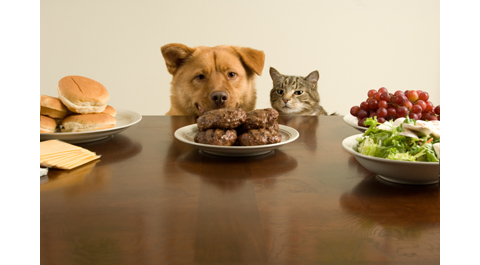 As we become increasingly more health conscious about what we eat, there is growing awareness that what we feed our pets is also important to their health, vitality and wellbeing.
As we become increasingly more health conscious about what we eat, there is growing awareness that what we feed our pets is also important to their health, vitality and wellbeing.
More of us are switching to what we see as a more natural diet, avoiding anything highly processed, or containing artificial preservatives, colours and flavours, plus taking the time to read and understand food labels. Reasons for this include the increase of health issues, such as allergies and obesity, which could be connected to what we, and our pets, are eating.
This change with consumers has affected the way in which a number of pet food manufacturers have been developing their products. Formulating them to be more biologically appropriate for our cats and dogs.
What exactly is a biologically appropriate diet?
Cats: For cats, it’s moderately simple – felines are obligate carnivores, meaning they have to eat meat in order to survive. On the other hand, because dogs can survive on other foods, they used to be regarded as omnivores, like people.
Dogs: The anatomy of dogs, however, is very similar to cats, and they have all the physical traits of a carnivore – sharp teeth to tear meat, a hinged jaw to swallow prey quickly, a short and acidic intestinal tract to digest protein and fat quickly and a lack of the enzyme amylase used by omnivores to break down carbohydrates.
Because their digestive systems are primarily tuned to process animal-based proteins as compared to plant-based proteins, which can be a struggle to digest, both dogs and cats need protein from an animal source in their diet.
Carbs: Foods that are high in carbohydrates, such as grains, may contain natural ingredients but are not necessarily the best primary protein source for dogs and cats. As carnivores, meat should be their main source of protein, and the number one listed ingredient in any packaged food, so always check the label to ensure that your pet is not eating a high-grain formula.
Look for low- or no grain formulas and products that reproduce closely what cats and dogs would naturally eat in the wild – that is, a diet of raw meat and organs, containing all the fatty acids, vitamins and minerals required for a totally balanced diet.
Fresh & frozen: As more fresh and frozen foods are becoming more accessible to owners, feeding raw is a fast-growing trend. While it may initially require extra effort and research to do it correctly, it certainly isn’t a new thing, as raw pet food products have been produced for New Zealand animals and zoos for more than 40 years.
Today there’s a vast variety of pet food options available on the market. In the end, your pet’s health is the best indicator that what your feeding them is right – if they seem healthy, bright-eyed and bushy-tailed, then keep up the good work!

Article supplied by pet.co.nz










Join the Discussion
Type out your comment here:
You must be logged in to post a comment.